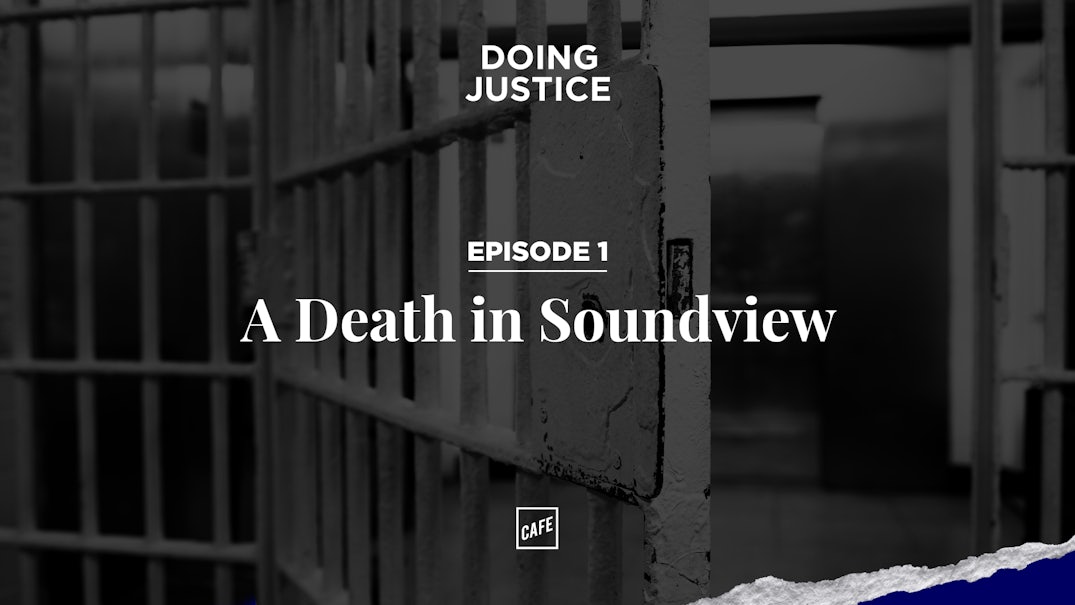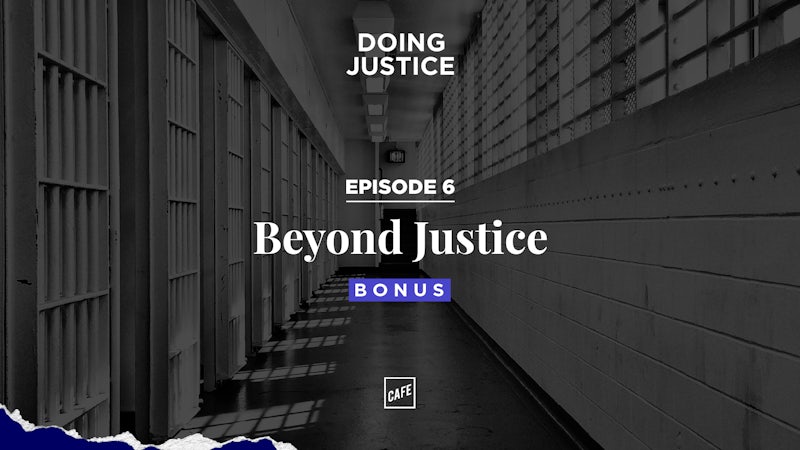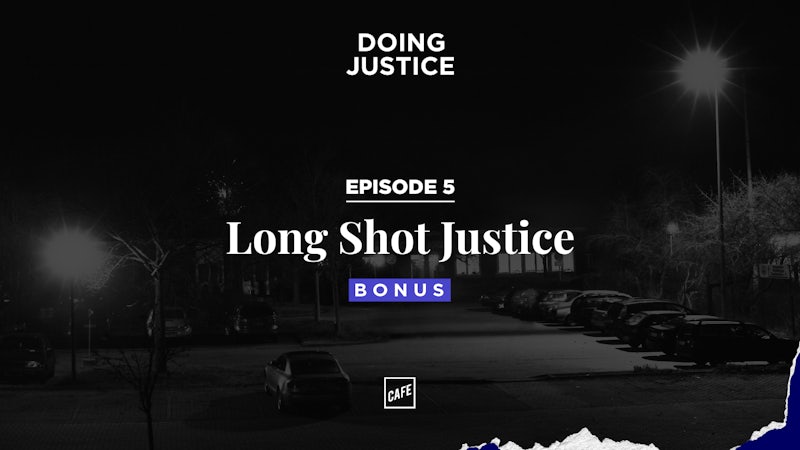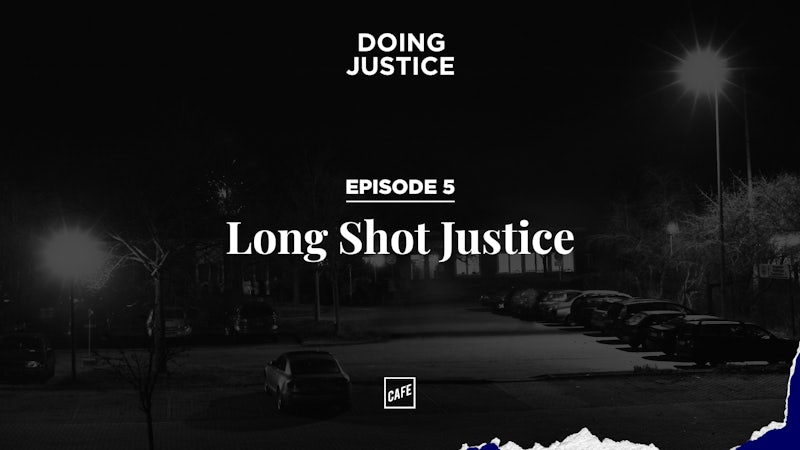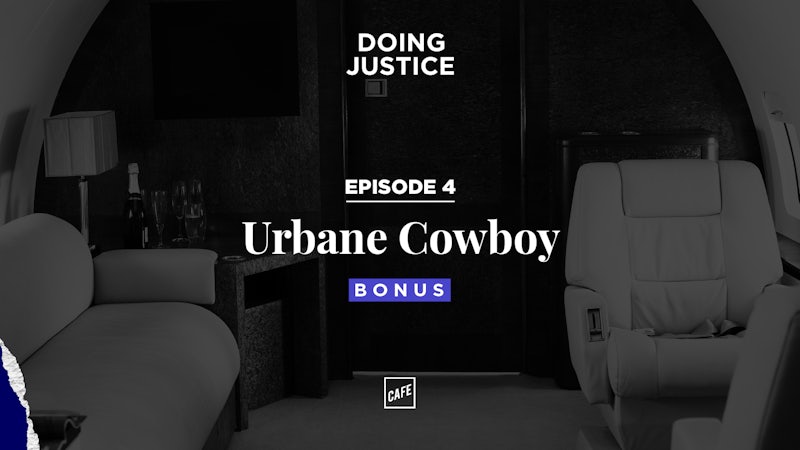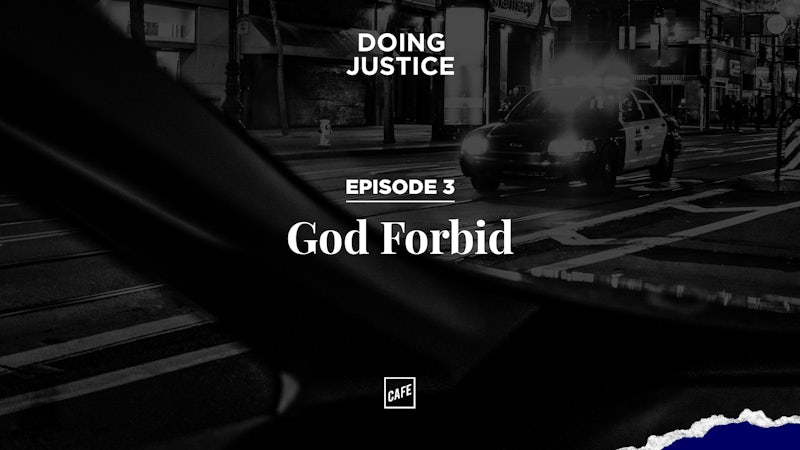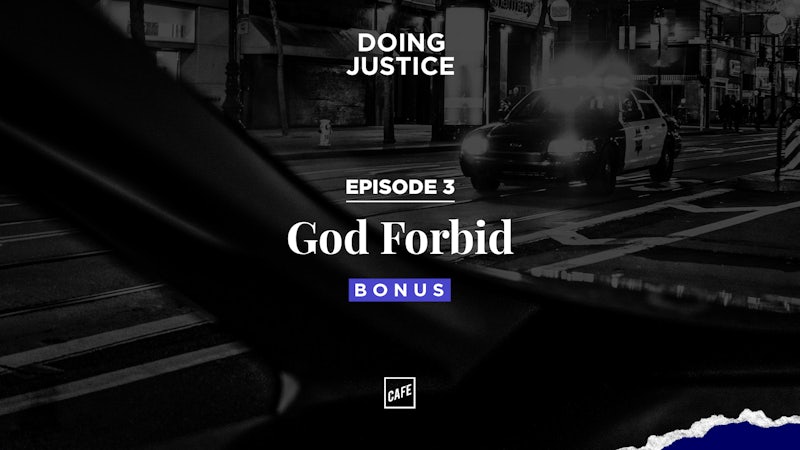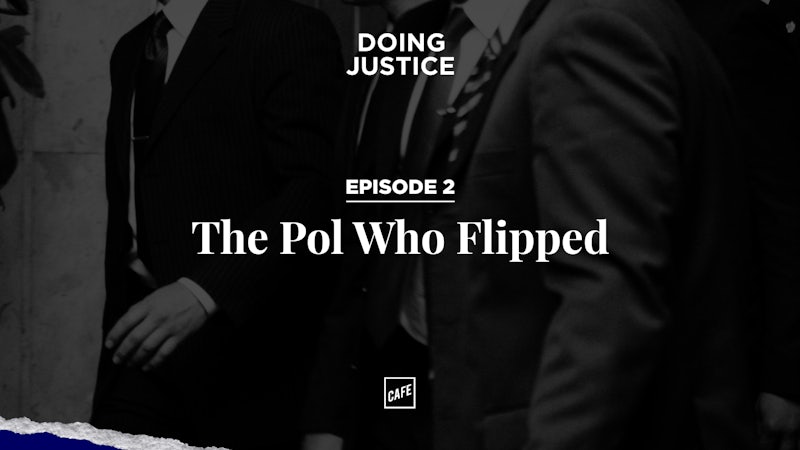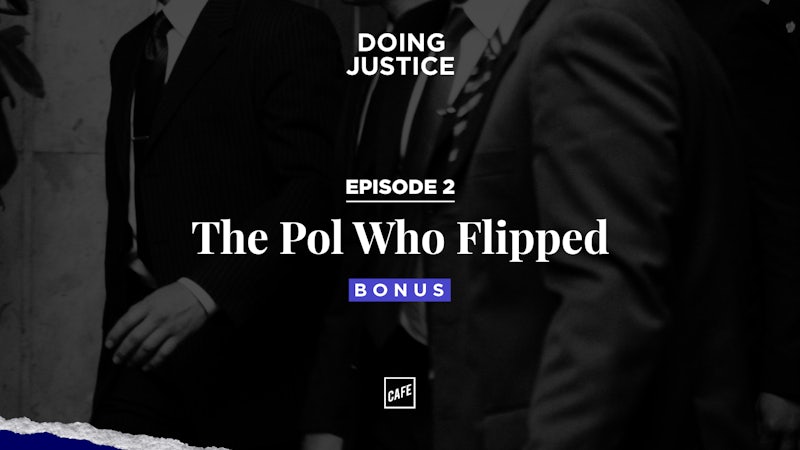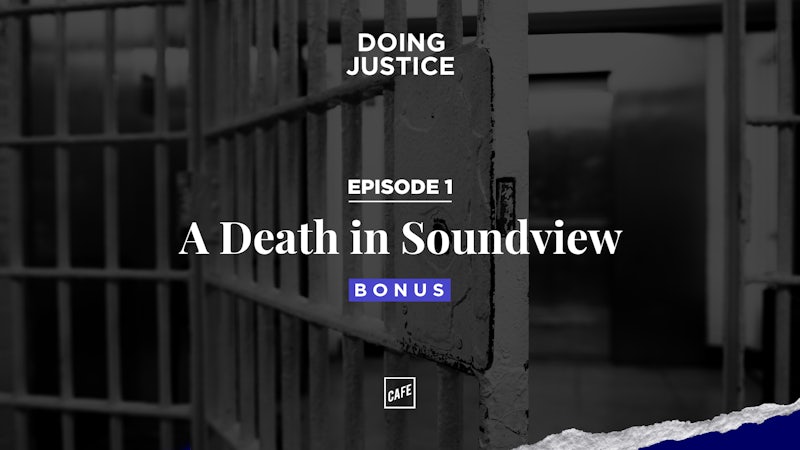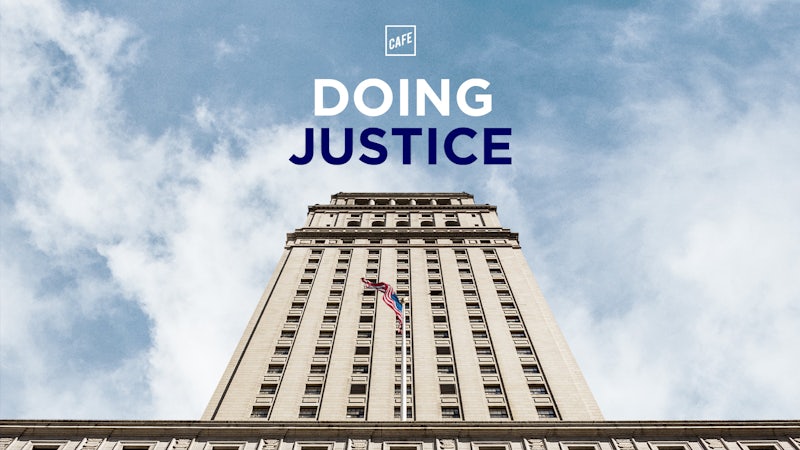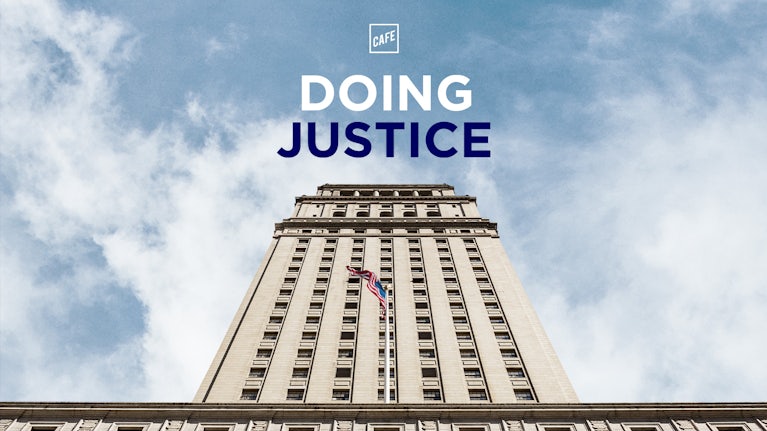John O’Malley: If Sing Sing was a condo it would be $1 million condos. If you ever walk out of Sing Sing and look at the view across the Hudson river you will not believe it. But once you get into those doors it’s a creepy creepy joint.
Preet Bharara:
John O’Malley was a cop with the NYPD for 21 years. He’s lost count of how many times he went to Sing Sing… usually when he was working on a case and needed to talk to an inmate. But when he walked into the prison in the summer of 2012, it was different: O’Malley was the one with news… for a convicted murderer named Eric Glisson.
Eric Glisson:
I was scared. Someone wants to see me. I have to go to the front of the prison. And there, that’s an indication that you’re telling on someone or you know you have a new charge. Some detectives is coming to rearrest you or whatever.
John O’Malley:
This time, they took me to a different part of the jail where they had visits and stuff like that So, I’m waiting in the office. I don’t even think I sat down. I don’t remember if there was even chairs.
Eric Glisson:
I thought, What they’re going to accuse me of now? What are they saying I did now?
Preet Bharara:
Eric had been in prison for 17 years… he knew, when a stranger pays you a surprise visit, it is not a good thing. He was so worried, he went into the room only after the guards threatened him.
Eric Glisson:
They opened the door and this guy is just sitting at the desk with glasses down to his nose looking reading some papers. But when he looks up his eyes it’s like Real blue and piercing and he had a big photo of me on the desk so that wasn’t good.
John O’Malley:
I had an idea what Eric would look like from his mugshot that I, you know, when I printed it out. And all of a sudden an inmate and it looked like him. He turns the corner, he walks in the room, he takes a look at me.
Eric Glisson:
And he looks like he’s a real detective Like one of those guys that their whole life they knew they wanted to do the right thing
John O’Malley:
You know, he walks in the door and he takes a look at me and he says, who the fuck are you?
Preet Bharara:
I’m Preet Bharara and this is Doing Justice. I’m a former US Attorney for the Southern District of New York– SDNY– basically, I was the head federal prosecutor in Manhattan. SDNY brings big cases: fraud. terrorism, organized crime, government corruption. You name it, we did it.
The legal system is about doing justice…. And from the outside, it’s not always clear how that works… how we take all the evidence and testimony and draw a hard line about what’s right and what’s wrong.
The legal system is like a machine that takes the mess of every case and delivers a simple judgment: guilty or not guilty.
And there’s a lot riding on that work…. Victims deserve justice, and people who are accused deserve a fair trial. The public–all of us–deserve a rule of law that keeps us safe.
The machinery of justice is complicated. And it’s operated by human beings. In the end, justice is served, or thwarted, by people. People who are fallible and flawed, who come with biases and blindspots.
When you ask Eric Glisson about himself, the first thing he’ll tell you about is his daughters. His five-year-old, Scarlet, is really into space right now.
Eric Glisson:
We watch a lot of space and she watches the space astronauts, the female space astronauts and she loves it. We even took a soccer ball and I made a helmet. I cut it and I put a piece of plastic in the front so she puts it on her head and she’s space walking.
Preet Bharara:
These days, Eric spends most of his time playing with his kids. Right now, he’s building them a playground in their suburban backyard.
Eric Glisson:
I try to instill in her, girls can do anything. (1:27:28) You could go to the moon if you want. You could go to space if you want.
Preet Bharara:
Eric never imagined that he would end up here: a stay-at-home dad preaching girl power.
He grew up in the Soundview section of the Bronx, when the area was pretty run-down and pretty dangerous. His childhood wasn’t easy.
Eric Glisson:
I wasn’t an angel when I was growing up. I didn’t have a father I didn’t have guidance. My mother died when I was 12. She was very ill. I was raised by my grandmother and a few of my uncles but I didn’t have that direction, where they made sure I went to school and things like that, but I basically raised myself.
Preet Bharara:
He dropped out of school after the fifth grade and spent his time hanging out with friends and working odd jobs like mowing lawns and shoveling snow. In 1995, Eric was 18 years old, living in a shared apartment across the street from his grandmother’s place. He and his girlfriend were expecting their first child.
Eric Glisson:
I used to go with to every appointment every doctor’s appointment every sonogram everything And then we had Cynthia and we brought her home from the hospital…
And like a week after that I was arrested for a crime I didn’t do
Dateline:
Time now is approximately 7:15am on January 19th, 1995.
A livery cab driver named Baithe Diop was found slumped over his steering wheel, shot multiple times, the victim of an apparent robbery. The driver’s money and cell phone were missing.
Preet Bharara:
Baithe Diop was murdered in the middle of the night, just doing his job, dropping off some passengers. As he was dying, the cab rolled down the street and crashed into a dumpster in front of a schoolyard. It happened right around the corner from Eric’s apartment.
When the police started asking around, a woman who lived nearby said she’d looked out her bathroom window and seen Eric running away from the crime scene. A couple of days later, Eric was arrested. It wasn’t the first time. He’d been arrested a couple of times for fighting, nothing serious. He was a minor then and he was never convicted. This time it was different.
The police forced their way into his apartment, and pinned Eric to the ground, with a knee in his back. At first they said they were arresting him for burglary. But when they got to the precinct, they started asking him about some cab driver and finally told him what he was really there for: murder.
Eric Glisson:
You wonder why this is happening Is it really true/ When are they going to say the joke is up? But you find yourself going through all of these processes with the court with uh the detainment Rikers Island the Bronx house and you’re like this is really true. It’s happening.
Preet Bharara:
The police arrested five other people for the murder, too… Eric had never met any of them. There was no physical evidence tying Eric to the murder. In fact, there was no physical evidence tying ANY of the so-called Bronx Six to the crimes they were accused of. The case was based on witness testimony alone.
Eric spent two years at Riker’s Island waiting for trial. Finally he ended up in a Bronx courthouse.
Eric Glisson:
So ultimately you go to trial. You’re expecting the system to work. But that doesn’t happen. You’re convicted and ultimately sentenced to 25 years to life. So it’s apparent that this is a railroad but who can you tell. You can scream it out but no one will listen and you stay there looking at the door, wondering when is it ever going to open?
Preet Bharara:
John O’Malley lives with his wife on a quiet suburban cul-de-sac. He’s a kind of classic hardboiled detective type, so I didn’t really expect him to live someplace so… cozy. I visited in late December, and every inch of the house was decorated for Christmas —
There were elves and wreaths and red-and-green plaid ribbons. A big glittering tree by the fireplace.
Preet Bharara:
How long have you guys been here in this house?
John O’Malley:
20 years in this house. In the town, since 86.
Preet Bharara:
Back in 1995, while Eric Glisson was just beginning to deal with a murder charge, John O’Malley was ending his career with the NYPD.
Why did you become a cop?
John O’Malley:
You know what, it was something that I always knew I wanted to be.// And even if I look back at my yearbooks and things like that, everybody in the yearbook would, you know, say, good luck, Johnny O in the NYPD good luck with the FBI.
Preet Bharara:
John grew up in the same neighborhood where Eric did: Soundview. In fact, the schoolyard next to Baithe Diop’s murder scene? John knew it. He used to play ball there as a kid.
He knew the Bronx inside and out. He spent his career there, investigating crimes just like the Diop case..
John O’Malley:
When I was in homicide, that was at the height of the crime in New York in the late eighties early nineties. /// there wasn’t a day or a week that went by that I wasn’t responding on a murder
Preet Bharara:
After 21 years with the NYPD, he moved from being a homicide detective to being an investigator at SDNY.
John quickly got a reputation for two things. One: his encyclopedic knowledge of Bronx street crews and gangs. Whenever we’d get a letter with a tip about a gang-related crime, we’d pass it directly to John – didn’t matter who it was addressed to.
John O’Malley:
For the last 30 years, my life is all it’s been is murders, murders, assaults, shootings and things like that. I’d wake up in the middle of the night dreaming about these cases or thinking about these cases. It sounds crazy. And I’d have a thing next to my bed, where I’d write it down so I wouldn’t forget it the next day. And when I talked to detectives, they tell me the same thing. They say, you live it, you know things always on your mind. So. It’s just our life. You know, you do remember things.
Preet Bharara:
John also had a reputation for flipping witnesses — that’s getting people to testify against the guys they committed crimes with.
A lot of the time, the only people who witnessed a crime are the people who did it. So being able to get them to talk… it makes or breaks a lot of cases.
John O’Malley:
First of all, they have to admit to the charge crime, and have to admit to basically everything they’ve ever done in their life criminally, you know, up until that point.
Preet Bharara:
Whether or not. The cops already know about it.
John O’Malley:
Correct, correct. And it doesn’t mean that they’re going to be charged with everything, there might be things, some sometimes outside the statute of limitations, but we still have to know about it. And the judge at the time of sentencing// will know the whole criminal history.
Preet Bharara:
You got to confess all your sins.
John O’Malley:
Absolutely.
Preet Bharara:
You know, I’ve had this discussion with lots and lots of people who can’t believe that a guy who’s up on one robbery charge would admit to seven other robberies that the feds don’t know about. What’s the incentive for somebody who’s in the crosshairs of law enforcement to confess and admit all this other stuff?
John O’Malley:
That’s a great question because, you know, even I at the beginning would say, what? Why would these guys do this? But let’s just give you an example. So we would do our homework. We’d have like a set book. A set book had every guy we knew that was in that gang or that crew. And that set book would be on our desk when we’re about to try to flip somebody.
And what we would do is say, listen, you know, here’s the book. You can look through that book right now. What you don’t know is who else we have in custody already; Who in a year from now we’re going to have in custody. So you may think that you could come in here and get over on us and give us half a loaf of bread when we want the whole loaf, until a year from now. We may get somebody else comes in, sits right in the chair that you’re sitting in. And they, and they blow you out of the water with something that you didn’t tell us.
Preet Bharara:
How many guys do you think you flipped over your career?
John O’Malley:
Oh, hundreds. Hundreds
Preet Bharara:
Do you still hear from any of them?
John O’Malley:
Yeah. I do. You know, there’s a couple of guys that always call me or text me and I remember sitting here one day, it was father’s day, and I had about three bings in a row, like bing bing on my phone, and it was three separate cooperators saying happy father’s day. And I remember saying to my wife, I go, man, I got two sons. I didn’t even hear from them yet! It’s really amazing.
Preet Bharara:
Eric Glisson went to prison when he was just 21 years old. He walked in knowing he would spend 25 years behind bars, 25 years as an inmate number on a prison roster.
Eric Glisson:
Nine seven A seven zero eight eight no one will ever forget that — no one who’s been incarcerated. You see so much violence in there. They’ll cut you if you’re part of another gang, they’ll cut you If you don’t give them money to buy drugs or something. They have knives in there – real knives- and they don’t hesitate to use them. In there, your life is basically nothing.
The key to retaining your life back is grabbing yourself by the chest and looking in the mirror and say listen man what’s going on? Who are you? I learned that I had a lot of weaknesses that I didn’t know existed. When you’re growing up, you want to be tough You want to be strong you want to be invincible but when you’re alone and you in the cell and there’s no one else there, you come to terms of a lot of things- if you have the guts to face it.
Preet Bharara:
There are different ways to cope in prison. Some inmates join gangs. A lot of them use drugs. Eric didn’t want that kind of escape. What Eric wanted was his freedom. So, he focused on appealing his conviction.
His public defender filed an appeal. But the court denied it.
Eric knew he only had a few chances to appeal, and he wanted to get it right. So he spent hours and hours in the prison’s law library, working on his case. And he read other stuff too… History. Science. Math. He got his GED, and enrolled in college courses.
Working on his own case was a big challenge, even from a practical standpoint – the photocopier in the law library was really expensive… and prison jobs don’t exactly pay well.
Eric Glisson:
You’re making 6 cents an hour in there/ You’re making $3 to $6 every two weeks
Preet Bharara:
So Eric studied some technical manuals… learned about electronics and he started freelancing.
Eric Glisson:
So I fixed everyone’s radio. I fixed the microwaves in the the officers’ quarters and they would let me out for a little extra time or whatever. I fixed their fans I fixed typewriters.
Preet Bharara:
Eric can build you a tattoo machine using a discman, a Bic pen, and a guitar string.
But meanwhile, his appeals were denied, one after another.
Eric Glisson:
Denial denial denial denial denial. It takes that fight out of you and that’s where you have to dig deep into yourself to continue on. Because I know If I was to get out of there, I had to bring home a new man to my family.
Preet Bharara:
In 2006, after more than a decade behind bars, Eric lost his final appeal.
His next shot at getting out of prison would be his first parole hearing — and that was 14 years away.
Eric Glisson:
That was one of the lowest points because now I have no remedies – nothing – I’m stuck in prison.
Preet Bharara:
Then, Eric had his first stroke of luck. There was a volunteer at Sing Sing who believed that Eric was innocent. She convinced a lawyer-friend to take on Eric’s case.
Peter Cross:
My name is Peter Cross. I’m an attorney here in Manhattan and I handle problems that small and large businesses have with each other.
Preet Bharara:
Peter had no experience with cases like Eric’s but he knew he was Eric’s last hope and the more he talked to him, the more faith he had in Eric’s innocence. So he agreed to work on it – pro bono.
Peter Cross:
Eventually I saw that, uh, he was in fact innocent based on the physical evidence that there was available about the case. But since Eric had exhausted all of his appeals, I came to believe that, uh, the only way we were going to get Eric out is if we could identify the actual killers.
Eric and I basically, we worked together. We spoke on the phone a lot.
Eric Glisson:
I would call his office his secretary would do research for me. She’ll Google something.
Peter Cross:
We were always doing freedom of information act requests.
Eric Glisson:
Doing freedom of information requests. They deny you and you continue on. they deny you, They deny you.
Peter Cross:
He would come up with ideas.
Eric Glisson:
I wrote people to find out things for me. I had people go into the crime scene taking photographs for me.
Peter Cross:
And he was always asking his relatives and friends for information about who we thought were the, for him, like the prime suspects as to who actually be, uh, the murderer.
Eric Glisson:
I read everything I looked at the newspaper every day looking for something
Preet Bharara:
Eric started saving newspaper clippings about people who’d been exonerated. He pasted them all over the wall of his cell.
Eric Glisson:
My wall of hope because I looked at it all day and it inspired me to continue on the fight
Preet Bharara:
Over six years, and countless phone calls, they grew close. Peter really cared about Eric and his case.
Peter Cross:
The firm that I was with when I first took Eric’s case — I think they got tired of my working on it and, well, let’s put it this way. They wanted to change the relationship I had with the firm. So I ended up going elsewhere. Eric’s case was actually responsible for me switching law firms a few times.
Preet Bharara:
Finally, in 2012, Eric and Peter had a theory about who the real killers were, guys from a Soundview gang called Sex Money Murder. My office–SDNY– had just successfully prosecuted a couple of the leaders of the gang. It was big news.
Eric and Peter saw the case, and Eric wrote a letter to my office.
Eric Glisson:
I am writing because I along with several other people some of whom I don’t know were convicted of a crime related related to the murder of Baithe Diop. I have recently been informed that two individuals were the actual ones who committed that crime, as initiation into the SMM gang.
Preet Bharara:
Coming up, Eric’s letter finds its way to John O’Malley — and the case takes a new twist. That’s after the break.
Before the break, Eric Glisson wrote a letter to my office.
Eric Glisson:
Two individuals were the actual ones who committed that crime, as initiation into the SMM gang.
Preet Bharara:
Whenever information about a homicide landed at S-D-N-Y, we would always forward it to John O’Malley.
John O’Malley:
So one day I get this inter- office envelope, my name on it, and I open it up and I recognize it right away as a letter from. A correctional facility, specifically Sing Sing.
Preet Bharara:
This would end up being Eric Glisson’s second stroke of luck: his letter reached someone with a long history of tracking these gangs.
John O’Malley:
It wasn’t a long letter, I think maybe a page and a half. And the beginning of it, I was like “oh, Another guy just, you know, spouting about, he knows something about a case” and, and I think at the very end it said something like, “please help me. I’m in jail for this and I didn’t do it.”
And I remember getting a chill, you know, down my back of my neck, cause I knew what the case was about. And it was an ‘Oh shit’ moment. It really was. It was like, Holy crap.
So I immediately run a rap sheet from my desk. And there’s no doubt now that this guy has been arrested for a cabbie murder that 10 years earlier, members of Sex Money and Murder confessed to me that they had done that murder.
Preet Bharara:
Ten years earlier, when John was flipping a witness on some other case, the guy also confessed to shooting a cab driver. From the moment he read the letter, John had good reason to believe that Eric was innocent.
Eric’s third stroke of luck? John remembered that confession, in part because it had happened in the neighborhood he grew up in.
John O’Malley:
Soundview, it was Croes Avenue, I believe. And it is a, there’s a park there that I used to play ball in when I was a kid. So I think that had a lot to do with it also, because, you know, I knew the area and I remember the cabbie murder was right there, near the school yard and, uh, and I played in that schoolyard.
Preet Bharara:
He immediately brought it to Margaret Garnett, the chief of the violent crimes unit in our office. Margaret comes from a family of generals. Her great-grandfather and both her grandfathers were high ranking generals. Her father was career army, too. She’s a leader like that. Tough, disciplined, dedicated.
Margaret Garnett:
John came to me and he said, I think it’s possible that this guy is in jail for this murder that he’s talking about in the letter. And if he’s, if that’s true, then I don’t think he’s the person who did it.
Preet Bharara:
Margaret’s job at the US Attorney’s office was to prosecute violent crimes — But really, our main responsibility as prosecutors is to always seek justice. People don’t usually think of prosecutors as exonerators, but it’s part of the job too.
Margaret Garnett:
There never was a question in my mind that if it was true that Eric Glisson had not committed this murder and had not participated in it in any way, that we had a responsibility to get to the bottom of it, and // either prove or disprove his claim that he was in jail for something he didn’t do.
Preet Bharara:
I remember being briefed on the Glisson case in my 8th floor office. Clearly we needed to act.
So Margaret and John got to work. John tracked down Gilbert Vega and Joey Rodriguez, the guys who’d confessed to the cabbie killing a decade earlier.
John O’Malley:
What had happened was, they were in Manhattan with some girls or something, and, uh, they wanted to go back to the Bronx and they hailed the gypsy cab and you know, the cab driver drove them to the Bronx and on the ride back they knew they didn’t have any money. So they’re talking to each other, says, we’re going to have to rob this guy and you know, we’ll just jump out of the cab. And when the cab stopped. There was an altercation and shots were fired and, they jumped out of the car. But before doing so, they took the cabbie’s cell phone and they ran. Vega wasn’t even sure that they had killed them..
Preet Bharara:
So you got the confession from Vega, then you get the confession from Rodriguez, but to get them to plead guilty to that crime, you wanted to find the paperwork that should’ve existed if there was a murder in the Bronx.
John O’Malley:
Correct. And so I call the 43rd precinct. I said, look, I’m looking for this open murder, a cabbie murder, you know, around this area. And they got back to me and said, we don’t have anything like that, so I said, you know, are you sure? He goes, yep, we don’t have any open murders. No cabbie murders. At that time it really wasn’t unusual for me because before Vega said he wasn’t sure if the guy was killed, and I thought maybe the guy was able to drive away and go to another hospital. Plus in the past, I’ve had other guys come in to me and telling me they murdered people and I found those people alive. You know? So it’s, [laughter]
Preet Bharara:
Because I think you once said, you know, not every shooter stops and checks the pulse.
John O’Malley:
Exactly.
Preet Bharara:
But part of the reason there was no open case was they had made a case against Eric Glisson and others
John O’Malley:
Exactly. When I asked for open homicide file on a cab driver, the case was closed because they had made an arrest. And I never would have imagined that, you know, that there would be a wrongful arrest here. But you know, 10 years later I’d find that out.
Preet Bharara:
Do you think anybody at the four-three was being cute with you?
Preet Bharara:
No, absolutely not. No.
After reading Eric’s letter, John contacted Gilbert Vega and Joey Rodriguez just to make sure they didn’t have any other accomplices. They said they didn’t.
It was mid-June when John went to Sing Sing to meet Eric. He drove up from the city with the Hudson River to his left; rolling hills and spring-green forest to his right; From far away, Sing Sing looks like a cluster of brick industrial buildings. When you get closer, you notice the barbed wire.
Eric had spent so much time trying to get the right people to listen to him, to believe that he was innocent. After seventeen years, he’d given up on good news.
John O’Malley:
He walks in the door and he takes a look at me and he says, who the fuck are you? I introduced myself, I’m from the US Attorney’s office in Manhattan. I says, I got your letter. And I said, listen, I know you’re innocent. I know who did this.
And immediately his whole demeanor changed. He just like, you know, he’s almost like his knees buckled at that time. And he’s like, what do you mean? I said, listen. I know who did it. I know you didn’t do it.
Eric Glisson:
I was just looking in a haystack I was looking for that needle and finding nothing. But then that day I got stuck and I knew there was no more searching. John O’Malley was like Jesus walking on water.
John O’Malley:
I shook his hand, I think i even apologized and I said to him, you know, we’ll get to the bottom of this. We’ll get you outta here.
Preet Bharara:
When John left the prison, he called Eric’s lawyer, Peter Cross. Peter was in line at the bank when he got the call.
Peter Cross:
He said Mr. Cross, I’m John O’Malley from the Southern District of New York. I just met with your client because I received his letter and I told him that I know he’s innocent. I’m sure I was pretty much speechless. I’m sure I thanked him. I get … [laughter] It was a good moment…one of the best moments in my life.
Preet Bharara:
To get an exoneration, the defendant needs to file a motion to vacate their conviction based on new evidence. The prosecutors–in this case the Bronx DA–can either agree with the motion, fight the motion, or remain neutral. It’s fastest and easiest when the prosecutors agree with the motion or do nothing. That’s what we were hoping for.
So John and Margaret scheduled a meeting to tell the Bronx DA about the new evidence.
Margaret Garnett:
The first meeting that we had, which I remember very clearly because it was the day that we were having a violent crimes unit summer outing at Yankee stadium. And the Bronx district attorney’s office is right down the street from Yankee stadium.
Preet Bharara:
The D.A.’s office is on a tree-lined boulevard not far from a small, manicured park named for Alfred Joyce Kilmer, who’s considered one of the worst poets ever. His best-known work goes, “I think that I shall never see a poem lovely as a tree.”
As you get closer to the DA’s office, the trees give way to check cashing places… bail bondsmen… defense attorneys’ offices with brittle, yellowed signs that look like they’ve been there forever.
In the DA’s office, John and Margaret met with Ed Talty, the longtime chief of homicide there, and Sean O’Toole, the head of Bronx homicide in the NYPD. These were the guys responsible for solving and prosecuting all the murder cases in the Bronx.
Margaret Garnett:
John had known Sean O’Toole for decades. Um, they had served together in Bronx homicide. And Ed Talty, he and I talked probably once a week as partners in, kind of two agencies investigating murders in the Bronx and had, I think John and I both felt that we had good professional, respectful relationships with both ed and Sean and //we expected to go into the meeting and that they would share our concerns.
Preet Bharara:
Margaret and John thought the Bronx DA and NYPD would take one look at the gang members’ confessions to the Diop murder and quickly do the right thing.
Margaret Garnett:
And that was not the way the meeting went.
John O’Malley:
The meeting didn’t go as well as I thought it would go. I mean, they listened, but you could tell that, you know, they didn’t want to hear what we were saying.
Margaret Garnett:
They did not seem concerned. I think Lieutenant O’Toole in particular was very resistant, and he said that he remembered the case very clearly. It was rock solid. And we didn’t realize going into the meeting, but Lieutenant O’Toole … he’d been on the arrest team when Glisson was arrested for the Diop homicide.
John O’Malley:
I guess it was the silence and the way they reacted that kinda surprised me. That’s all. I just expected, you know, a little bit more. Like when we left, I described it to Margaret as, you know, don’t let the door hit you in the ass type thing.
Margaret Garnett:
And I remember John and I leaving the meeting, walking down the street to Yankee Stadium to meet our colleagues. Both of us kind of stunned silence for the first block or two, trying to make sense of what had happened.
Preet Bharara:
John and Margaret came to a stunning realization. The Bronx was actually going to fight the motion to vacate Eric’s conviction. And that meant that Eric would remain in prison for who knows how long.
Margaret Garnett:
I mean, prison is, can be a very dangerous place. I think we both felt that if something were to happen in prison, whether a health issue or being the victim of some kind of violence that that would just be something that we would have a really hard time living with.
Preet Bharara:
The first thing they had to do was get the case files… and they weren’t going to get them from the police or DA, so they got what they could from Eric’s lawyer.
Margaret Garnett:
We got the trial transcript… three or four bankers boxes of paper and John and I both started reading sort of in parallel whenever we had a spare minute during our day. And I can remember we would see each other in the halls, or one of us would come into the other’s office and say like, how far are you? Like, have you seen this? We would leave little highlighted or yellow flagged pages from the transcript on each other’s chairs.
We needed to prove that the cabbie murder Vega and Rodriguez confessed to WAS the Diop murder. It seemed clear — the location of the crime scene was the same; the wounds on the victim were the same; the description of the driver was the same.
Preet Bharara:
They looked closely at the prosecutor’s case against Eric and began to pick it apart. First, there was no physical evidence linking him to the crime — no weapon, no fingerprints, no DNA. It all hung on the word of one witness, the woman who said she’d looked out of her bathroom window and seen Eric running from the scene.
But John looked over the records and realized that she couldn’t possibly have seen anything clearly. Her apartment was too far away, the angle was wrong, and it was dark at the time of the murder.
Also, that one witness? She was Eric’s ex-girlfriend, a woman he’d jilted. And during the initial investigation, she kept changing her story — she wasn’t reliable.
Margaret Garnett:
Reading the transcript of the original trial, I was shocked that they had convicted them. I mean, I thought the evidence was very thin. So that was definitely a takeaway of mine from the transcript that, Oh my God, I can’t believe that they managed to convict these people on this evidence.
Preet Bharara:
So the case was weak, but the conviction would stand unless Margaret and John found more definitive proof… And They found it in one of those banker’s boxes full of documents. Vega and Rodriguez had told John that after they shot Diop, they stole his cell phone. That was the key.
John O’Malley:
The phone records showed like minutes after the shooting that they were calls made to certain people, and one of the persons that was called was related to Joey Rodriguez, Joey Green Eyes.
Preet Bharara:
So is there an argument that had that evidence been exploited back in 1995 things might’ve turned out differently?
John O’Malley:
Absolutely.
Preet Bharara:
Back in 1995, the Bronx prosecutor had the cell phone records. But he didn’t share them with the defense. He and the judge believed they were irrelevant to proving Eric’s guilt or innocence. The phone records weren’t released until more than ten years later, thanks to one of Eric’s many Freedom of Information Act requests. That’s how the cell phone records ended up in that banker’s box.
As the summer of 2012 wore on, we were all concerned that the Bronx DA wasn’t doing the right thing and admitting their mistake quickly enough. So Margaret kept in contact with them, trying to convince them of Eric’s innocence.
But three months in, Eric was still in prison and the Bronx DA still wouldn’t budge.
So we kept pushing.
Margaret Garnett:
What was true and right was very clear to us. And if we weren’t willing to take risks in service of that, then we really ought to just put our badges on the desk and, and walk out.
Preet Bharara:
That’s when we did something… unusual for SDNY… John O’Malley himself swore out an affidavit, attesting to Eric’s innocence.
John O’Malley:
John O’Malley hereby affirms under penalty of perjury. I submit this affidavit in connection with the motion by defendants, Eric Glisson and Cathy Watkins, seeking to overturn their convictions in the homicide of Baithe Diop. The general timeframe, the African driver. The location of the pickup and original drop-off request, the exact location of the robbery and shooting, tthe driver’s stolen cell phone with phone records, showing calls to associates of Vega and Rodriguez…
Preet Bharara:
The court reopened the case, and Peter thought his client would be free in a matter of weeks.
Peter Cross:
Little did I know it would take us months of fighting with the Bronx D.A. to get them to consent to Eric’s release.
Preet Bharara:
The DA postponed while the police spent months reinvestigating the case.
Peter thinks the Bronx was just dragging its feet – that they didn’t want to reopen the case, they didn’t care about Eric and the others, and they definitely didn’t want them to be exonerated.
Peter Cross:
They didn’t want to admit that they made a mistake and put these people in jail for all these years and have a wrongful conviction case. I mean, this case was so stupid to begin with, all right, that once it started to fall apart, it was really gonna fall apart.
Preet Bharara:
Even John O’Malley was surprised at how long the re-investigation took…
But John doesn’t think the police were stonewalling; he says they were just doing what they thought was right.
John O’Malley:
Lieutenant O’Toole is a lieutenant who’s been there for 20 years. And One of the greatest guys I’ve ever worked for or with. I would back him, you know, to the end, I mean, the guy’s a brilliant guy and an honest guy, and. I didn’t like some of the things that were being said about him.
Preet Bharara:
Do you have a view about how this went wrong back in 95?
John O’Malley:
You know, I thought about that I don’t know, I mean, before we can make an arrest on a homicide, we have to call the assistant district attorney and they have to approve that arrest. And they’re not going to give you the approval unless they feel they have a winnable case. Then there’s an ADA that’s assigned to the case. The ADA that did this case was one of their top guns. I know him very well. And now you have a jury of 12 people in the Bronx and the Bronx, to be honest with you, I think they have the lowest conviction rate of any borough in the city, you know, so he, you know, he did have a case that, that went through all those processes and then goes to the jury and he gets convicted. So I guess my answer is I don’t have an answer for you as to how this happens.
Preet Bharara:
As for the Bronx DA and NYPD, they didn’t respond to our requests for comment on this case.
So much had to go wrong for Eric to get convicted. Things had to go wrong over, and over, and over again, for months.
Margaret Garnett:
It was a very personal reminder that the system is built on human beings, and so it’s inevitably riddled with failure.// people are flawed and get things wrong. But coming face to face with that failure and the human consequences of it, is just a reminder to like, Don’t be too sure that you’re right. Like never be too sure that you’re right and // Just to always be mindful of what the human cost is and that you better be sure.
Preet Bharara:
Eric walked out of prison in October of 2012. He was on conditional release, wearing an ankle monitor. The TV program Dateline filmed his first day of freedom.
Dateline:
It’s Oct. 22, 2012. Eric Glisson is finally a free man. And we are by his side as he experiences all of it.
Eric Glisson:
Oh! I seen this in a magazine!
Preet Bharara:
Eric’s first few hours of freedom are part exhilaration, part discovery – he’s never actually used a cell phone
Eric Glisson:
Hello? Hello? Where’s Cynthia?
Charmaine:
You got it upside down, Eric.
Preet Bharara:
Two days after his release, Eric started taking his college classes again.
Eric Glisson:
The same professor’s classes that was coming to sing sing
Preet Bharara:
Partly because he wanted to get his degree as soon as possible. And partly because school was now the one constant in his life.
Eric Glisson:
I was really conscious of my leg in school like walking up the stairs or sitting down and other students being able to see that you had that ankle monitor because it’s really bulky.
Preet Bharara:
Eric’s daughter Cynthia was almost 18 when he got out… Eric never really got to be a father to her. He didn’t have much family, and he didn’t have many friends on the outside anymore either. Most of the people grew up with, he says, were in prison or dead.
About a month after Eric got out, he asked John and Margaret to meet with him. He wanted to thank them in person. They met in a conference room on the first floor of the US Attorney’s office in Lower Manhattan. It’s a brutalist concrete building, close to the foot of the Brooklyn Bridge. Inside it’s no prettier. The furniture is shabby, and the people overworked. And it’s one of my favorite places to be.
John O’Malley:
And, uh, we all went in and, uh, shook hands and, you know, talked about the case a little bit.
Preet Bharara:
What did he say?
John O’Malley:
He was very grateful, you know, he said he, you know, he said, thank you so much to both myself and Margaret. I feel weird when he’s thanking me for doing the job i was supposed to do because (47:36) it was something that shouldn’t have happened. And it did happen. And I, and I just felt bad for him.
Preet Bharara:
John explained how Eric’s letter had landed on his desk…
how he’d flipped the two Sex Money Murder guys…
and how he remembered Baithe Diop’s death —
because it happened in front of the schoolyard where he used to play.
John O’Malley:
I even said to him, I said, listen, I hate to use the word luck with you because obviously you don’t have any, but you know, that part of it was luck for him. And, you know, he laughed about it and we left about it and this was a good turnout, unfortunately, you know, later than it should have been, but it was a good turnout.
Preet Bharara:
In 2016, three years after Eric’s exoneration, he and the other members of the so-called “Bronx Six” sued the city and state for wrongful conviction.
They won a 40 million dollar settlement.
That might sound like a lot. But no amount of money could give them back the 17 years they spent in prison.
In the years since then, Eric has gotten engaged and moved to a big house outside of the city, about an hour north of Sing-Sing. He runs some businesses but mostly, he’s a stay-at-home dad.
When Eric thinks about what happened to him, he says — amazingly — that he doesn’t feel angry.
Eric Glisson:
I explained it to myself by saying I’m not the only one There are more people out there I’m just one of the individuals that got caught up in in this serious injustice that’s going on in our country. I have to always keep a positive outlook in life I’ve trained myself for that because that was the only way I was going to get through
Preet Bharara:
I’ve turned Eric’s case over and over in my mind, wondering how six people could have ended up in prison on so little evidence…
We often hear stories like this, about poor people of color getting swallowed up by a system that’s meant to protect people.
In the case of Eric Glisson and his co-defendants, the best thing you can say is that a lot of people made a lot of mistakes.
Here’s the thing, the law doesn’t do justice. People do. Investigations are complicated. There are a million ways to investigate a case. There are also a million ways to get it wrong. Regardless, the people who work in the system every day bear a profound responsibility… to do their best to get it right, and to make it better when they get it wrong.
Margaret Garnett:
I think sometimes in lots of areas we have a tendency to think that. It’s too late, it won’t matter. Um, something terrible happened and, and that’s sort of all that matters. But I think just like human beings run the system, and so it’s prone to error. I think human beings also have this tremendous capacity to fix mistakes to right wrongs and it’s never too late to fix something that’s wrong.












